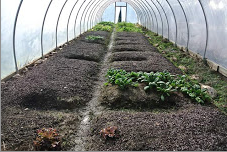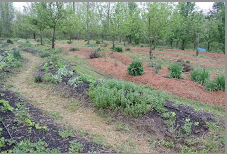Water management in the garden
Published 10:09 am Wednesday, October 4, 2017

- Freshly planted hugel at Crickets Cove Farm & Forge.
It has been about six weeks since we have had a good soaking rain here in Southern Virginia and the garden beds are thirsty. That being said, water has been weighing heavy on my mind.
Whether you landscape garden, vegetable, or patio garden, dry spells like the one we are experiencing now demonstrate firsthand the importance of a well thought out water management plan and techniques for the garden are.
All garden endeavors, no matter how large or small, should have one.
Trending
The soil in a planting bed is an extremely important component to water management. The quality, quantity and placement of it will determine how successful the gardener will be at capturing, utilizing and conserving water.
Healthy soil with plenty of organic matter will absorb and hold more water for longer periods of time. It also contains more nutrients that will provide for healthier plants in general. Healthy plants will be able to handle a water shortage (within reason) for a longer time period and with better outcomes than unhealthy ones.
As I have learned from my friends at Crickets Cove Farm and Forge keyhole gardening, the use of swales and Hugelkultur are all techniques used to capture and utilize water to its fullest in drought tolerant gardens.
Most Keyhole gardens are circular but they can be any shape or size. Keyhole gardens consist of garden beds inside a perimeter wall with small furrows surrounding the beds that allow water to flow through and/or collect. These furrows allow water to soak deep into the soil and provides more moisture in the beds for longer periods of time.
Swales work in the same way as keyholes do to capture and utilize water, usually on a much larger scale. The garden beds in Swale gardens are raised with large swales running alongside of each bed. In areas where water management in regards to the flow of excess water is also an issue, you will usually see swales.
Hugelkultur (pronounced Hoo-gul-culture) is a favorite of mine. A hugel is a raised bed designed to hold moisture and build fertility of the soil. Hugels can be large or small and utilize natural refuse like branches, leaves, grass clipings, straw, cardboard, manure, compost, logs and clean renewable organic materials.
The basic design of a hugel consists of a hole in the ground filled with logs and branches topped with sheet mulching and plantings. The result is a raised garden bed resembling an earthen mound. The logs and branches at the base of the hugel absorb water and hold onto it, providing the plants with moisture during dry times when most other gardens are in peril of drying up. Over time (years) the internal matter of the hugel breaks down providing a continuing source of composted nutrients for the plants.
I find the entire concept fascinating.
If you would like more information or resources on Permaculture, Keyhole, Swale and Hugelkultur gardening, email me I would be happy to hear from you.
Crickets Cove Farm and Forge is a USDA-Certified Organic and Bio-Dynamic farm in Victoria.
Dawn Conrad is a columnist for The Dispatch. She can reached at conrad.gardenmuse@gmail.com or fb.me/conrad.gardenmuse.




